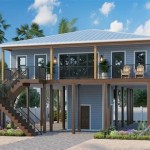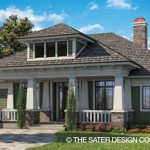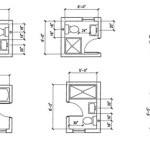Victorian House Plans: A Focus on One-Story Designs
Victorian architecture, a dominant style throughout the latter half of the 19th century, is typically characterized by ornate detailing, elaborate trim, and a romantic aesthetic. While often associated with multi-story structures boasting turrets, gables, and sprawling porches, Victorian principles were also adapted to one-story homes. Examining Victorian house plans tailored for a single level reveals a unique blend of architectural embellishment and practical living.
The Victorian era, named after Queen Victoria of England (1837-1901), saw a flourishing of architectural styles fueled by industrial advancements and a growing middle class. These factors allowed for mass production of building materials, making ornate details more accessible. While Queen Anne, Italianate, Gothic Revival, and Stick styles were common within the Victorian umbrella, their adaptation to single-story dwellings presents specific design considerations.
Understanding the Victorian Aesthetic in One-Story Homes
Adapting Victorian design elements to a single-story house requires a careful approach to maintain the style's characteristic grandeur without overwhelming the space. Key considerations include rooflines, ornamentation, and interior layout. While the soaring heights of multi-story Victorian homes are absent, strategic design choices can create a similar visual impact.
Rooflines become particularly important in single-story Victorian designs. Steeply pitched roofs, often incorporating gables and dormers, help to create a sense of height and visual interest. The use of decorative brackets and bargeboards along the eaves further enhances the Victorian aesthetic. Turrets, though typically associated with multi-story homes, can be incorporated on a smaller scale as a prominent feature on a corner of the single-story structure, adding architectural drama.
Ornamentation is central to Victorian design. This includes intricate millwork, such as spindlework, fretwork, and decorative trim around windows and doors. Porches, even on a smaller scale, are common and feature decorative posts, balustrades, and sometimes even gingerbread detailing. The exterior cladding can also contribute to the Victorian style, with options like clapboard siding, shingle siding, or a combination of both. Paint schemes often involve multiple colors, highlighting the various architectural details and adding depth to the facade.
Interior layouts in Victorian homes were generally more compartmentalized than in modern open-concept designs. Even in single-story configurations, separate rooms for living, dining, and sleeping were common. High ceilings, even in a single-story dwelling, were desirable to enhance the feeling of spaciousness and grandeur. Interior detailing, such as crown molding, wainscoting, and elaborate fireplaces, further contribute to the Victorian aesthetic within the one-story home.
Challenges and Considerations in Designing One-Story Victorian Homes
Designing a one-story Victorian home presents specific challenges that require careful planning and solutions. These challenges often relate to maximizing space, ensuring adequate natural light, and adapting the design to meet modern needs while preserving the architectural integrity of the style.
Maximizing space is crucial in a single-story dwelling. Without the advantage of vertical space, careful consideration must be given to room sizes and flow. Efficient floor plans that minimize wasted space are essential. The use of high ceilings, as previously mentioned, can help to create a sense of spaciousness. Incorporating built-in storage, such as shelving and cabinets, can also help to maximize usable space while maintaining a clean and organized appearance.
Ensuring adequate natural light can be a challenge, particularly in the center of the house. Strategic placement of windows and skylights is essential to bring natural light into interior spaces. Larger windows, especially in rooms that face the front or back of the property, can help to maximize natural light. The use of light wells or courtyards can also be effective in bringing light into interior spaces that might otherwise be dark.
Adapting the Victorian design to meet modern needs requires a balance between preserving the architectural integrity of the style and incorporating modern conveniences. Modern kitchens and bathrooms, for example, can be designed to blend seamlessly with the Victorian aesthetic. Incorporating modern amenities, such as central heating and air conditioning, also requires careful planning to minimize visual impact on the exterior of the house. Attention to details, such as using period-appropriate fixtures and fittings, can help to maintain the overall Victorian aesthetic while providing modern comfort and convenience.
Key Elements of One-Story Victorian House Plans
Specific architectural elements are crucial in defining the one-story Victorian home. These elements distinguish the design from other architectural styles and contribute to its unique character. Focusing on these elements ensures the preservation of the Victorian aesthetic.
Porches are fundamental to Victorian architecture, even in single-story designs. They provide a welcoming entrance and enhance the curb appeal of the house. The porches are often decorated with intricate details, such as turned posts, spindlework, and gingerbread trim. The size and shape of the porch can vary, but it is typically a prominent feature of the front facade. The porch serves as an outdoor living space, providing a place to relax and enjoy the surroundings. A well-designed porch can significantly enhance the overall aesthetic of the one-story Victorian home.
Windows play a significant role in the overall design. Large windows, often with multiple panes, are common in Victorian homes. Bay windows, which project outward from the wall, are also a popular feature. The windows are typically decorated with ornate trim and moldings. Stained glass windows can add a touch of elegance and color to the interior. The placement and style of the windows are carefully considered to maximize natural light and enhance the architectural aesthetic of the house.
Decorative details are essential to the Victorian style. These details include intricate millwork, such as spindlework, fretwork, and decorative trim. The exterior of the house is often adorned with brackets, bargeboards, and other decorative elements. Paint schemes typically involve multiple colors, highlighting the various architectural details and adding depth to the facade. The use of decorative elements adds visual interest and character to the one-story Victorian home. Paying close attention to these details is crucial to achieving an authentic Victorian aesthetic.
The adaptation of Victorian architecture to one-story homes presents a unique opportunity to combine historical charm with modern living. While the absence of multiple stories requires careful planning and design, the resulting structure can be a testament to architectural ingenuity and a comfortable, stylish dwelling.

House Plan 65084 Victorian Style With 1 Bed Bath Car Garage

One Story Victorian House Plan 86271hh Architectural Designs Plans

The Whitney 2880 3 Bedrooms And 2 Baths House Designers

Pin Page

Victorian Style House Plan 3 Beds 2 Baths 1820 Sq Ft 929 91

Victorian Style House Plan 3 Beds 1 Baths 1159 Sq Ft 25 4770 Houseplans Com

Plan 49571 Victorian Style With 2 Bed 1 Bath

House Plan 24718 Victorian Style With 1452 Sq Ft 3 Bed 2 Bath

House Plan 48190 Victorian Style With 874 Sq Ft 2 Bed 1 Bath

Victorian Style House Plan 3 Beds 2 Baths 1660 Sq Ft 1047 27 Dreamhomesource Com








